#primates in fragments
Explore tagged Tumblr posts
Text

👎
Various reasons. Hope he lands a gal with alopecia who's into deadbeat dads tho? And some boomers rubberstamp it? Apparently these are the things to look for? (Unless youre into coparenting with a "tribe of hairy women" and/or you assume when boomers are cool with something eg animal death, its because theyre shellshocked and trying to avoid controversy-gotchas)(which tbc im very into the first and assuming of the second, personally)
Shouldnt this scenario having no easy win con have opened up more dialogue about coming up with instant darts? I feel like theres some known paralytic that is amply effective

So there's something to build off here maybe, like fine tune it so its faster but nonlethal? ...or whatever...maybe some venmous fish or snake has something to offer to chemical synthesis here. This has so many applications outside this context.
But no everyone wants to stand around and say it had to be done, ho hum........cant think of anything new to do, we're just apes too
0 notes
Text
Round 3 - Reptilia - Psittaciformes




(Sources - 1, 2, 3, 4)
Our next order of birds are the Psittaciformes, commonly called “psittacines” or “parrots”. Psittaciformes contain the families Cacatuidae (“cockatoos”), Psittacidae (“holotropical parrots”), Psittrichasiidae (“black parrots” and “vasa parrots”), Psittaculidae (“Old World parrots”), and Strigopidae (“New Zealand parrots”).
Parrots are some of the most well known and recognized tropical birds. They have large, strong, sharply downcurved beaks, an upright stance, and clawed, zygodactyl feet (two toes facing forward and two back). They are the only animals that display true tripedalism, using their beak as an extra limb to generate propulsive forces equal to or greater than those generated by the limbs of primates when climbing vertical surfaces. They travel with cyclical tripedal gaits when climbing. Along with corvids, they are considered the most intelligent birds, and are able to use tools, solve puzzles, and mimic human speech; some have been shown to even associate meaning to human words. Most parrots feed on plant material like seeds, nuts, fruit, and buds. Some species eat small animals, eggs, and/or carrion, and lories and lorikeets are specialized for feeding on nectar and fruit juice. Parrots are found on all tropical and subtropical continents and regions including Australia and Oceania, South Asia, Southeast Asia, Central America, South America, and Africa, with the greatest diversity coming from Australasia and South America.
Most parrots are social animals which live in large flocks, and hold no territories other than their nesting sites. All are monogamous, and the pair bonds of the parrots and cockatoos are strong, with a pair remaining close during the nonbreeding season even if they join larger flocks. Almost all parrots nest in cavities such as tree hollows or termite mounds. In most cases, both parents excavate the nest, though in many, only the female incubates the eggs while the male brings her food and guards the nest. Their young are altricial, hatched naked and helpless.
A single 15 mm (0.6 in) fragment from a large lower bill (UCMP 143274), found in deposits from the Lance Creek Formation had been thought to be the oldest parrot fossil, having originated from the Late Cretaceous period. However, this fossil is more likely to have come from a parrot-like caenagnathid oviraptorosaur. It is still generally assumed that the Psittaciformes were present during the K-Pg extinction, 66 million years ago, with modern parrots evolving in the Eocene, around 50 million years ago.
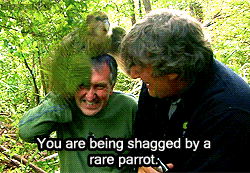
Propaganda under the cut:
A large macaw can have a bite force of 35 kg/cm2 (500 lb/sq in), close to that of a large dog.
Most species are capable of using their feet to manipulate food and other objects with a high degree of dexterity, in a similar manner to a human using their hands. A study conducted with Australian parrots has demonstrated that they exhibit "handedness", a distinct preference with regards to the foot they use to pick up food, with adult parrots being almost exclusively "left-footed" or "right-footed", and with the prevalence of each preference within the population varying by species.
Parrots eat a lot of seeds, and in many cases where they are seen consuming fruit, they are actually just eating the fruit to get at the seed. As seeds often have poisons that protect them, parrots will carefully remove seed coats and other chemically defended fruit parts prior to ingestion. Many species in the Americas, Africa, and Papua New Guinea also consume clay, which releases minerals and absorbs toxic compounds from the gut.
The large, nocturnal, flightless Kākāpō (Strigops habroptilus) (see gif above) is the heaviest parrot, weighing around 4.0 kg (8.8 lb). They are world’s only living flightless parrots, having evolved in New Zealand where they did not have to worry about land predators. Today, the Kākāpō is critically endangered, due to the introduction of mammalian predators like domestic cats, rats, domestic ferrets, and stoats. The current total known population of living individuals is 244, with all known individuals being named and tagged.
The Kea (Nestor notabilis) (image 4), also from New Zealand, is the only alpine parrot, living in the forested and alpine regions of the South Island. Kea are known for their intelligence and curiosity, both vital to their survival in a harsh mountain environment. Kea can solve logical puzzles, such as pushing and pulling things in a certain order to get to food, and will work together to achieve objectives. They have been filmed preparing and using tools. Their natural curiosity and urge to explore and investigate makes this bird both a pest for residents and an attraction for tourists, and they are known to play with (and damage) backpacks, boots, skis, snowboards, and cars. They are known to “steal” unguarded items of clothing, car keys, passports, and rubber parts of cars. Unfortunately, this naturally curious and trusting behavior has led to the endangered bird being illegally killed by poachers in some instances.
Some parrots are active predators of other animals. Golden-winged Parakeets (Brotogeris chrysoptera) prey on aquatic snails. The bulk of the Yellow-tailed Black Cockatoo’s (Zanda funerea) diet consists of grubs. While the Kea’s main source of protein is carrion, it also uncommonly preys on Domestic Sheep (Ovis aries), as well as other birds (including shearwater chicks), and small mammals (including rabbits and mice). Another New Zealand parrot, the Antipodes Parakeet (Cyanoramphus unicolor) is known to prey on adult Grey-backed Storm Petrels (Garrodia nereis) by entering their burrows while they incubate their eggs.
Lories, lorikeets (tribe Loriini), Hanging Parrots (genus Loriculus), and Swift Parrots (Lathamus discolor) are primarily nectar and pollen eaters, having adaptations specifically for this diet, including tongues with brush-like tips.
The Carolina Parakeet (Conuropsis carolinensis) is an extinct species of conure that was once native to the Eastern, Midwest, and Plains states of the United States. It was the only indigenous parrot within its range, and one of only three parrot species native to the United States (the only remaining is the Green Parakeet [Psittacara holochlorus] in some parts of Texas, while the Thick-billed Parrot [Rhynchopsitta pachyrhyncha] has since been extirpated from the US). Carolina Parakeets were hunted, both for the decorative use of their colorful feathers in women's hats, and for reduction of crop predation. Deforestation in the 18th and 19th centuries also likely played a significant role. They were also captured for the pet trade and competed for nest sites with the introduced European Honeybee (Apis mellifera). The last confirmed sighting in the wild of a Carolina Parakeet was in 1910. The last known specimen, a male named Incas, died at the age of 33 at the Cincinnati Zoo in 1918, and the species was declared extinct in 1939.
The endangered El Oro Parakeet (Pyrrhura orcesi) is one of the few parrot species known to breed cooperatively. One breeding pair may be accompanied by up to six helpers.
The Golden Parakeet (Guaruba guarouba) (image 3) is the only other parrot known to breed cooperatively, and they may also be polygamous breeders, with multiple females contributing to a clutch.
The Monk Parakeet (Myiopsitta monachus) is one of the very few parrots known to build a nest, and even among them it is unique. Monk Parakeets breed colonially, building a single huge nest, with separate entrances for each pair. These colonies can become quite large, with pairs occupying separate "apartments" in composite nests that can reach the size of a small car. These “apartments” may attract other tenants who will nest alongside the colony, such as pigeons, sparrows, American Kestrels (Falco sparverius), Yellow-billed Teals (Anas flavirostris), and mammals like squirrels.
The Burrowing Parrot (Cyanoliseus patagonus) excavates burrows that can be as much as 3 m deep into a cliff-face, connecting with other tunnels to create a labyrinth, ending in a nesting chamber. They nest in large colonies, some of the largest of any parrots, up to 70,000 strong, creating “cities” in cliff faces during the breeding season.
Parrots do not have vocal cords, so sound is accomplished by expelling air across the mouth of the trachea in the organ called the syrinx. Different sounds are produced by changing the depth and shape of the trachea.
A study by scientist Irene Pepperberg suggested a high learning ability in a Grey Parrot (Psittacus erithacus) named Alex. Alex was trained to use words to identify objects, describe them, count them, and even answer complex questions such as "How many red squares?" with over 80% accuracy. N'kisi, another Grey Parrot, has been shown to have a vocabulary of around a thousand words, and has displayed an ability to invent and use words in context in correct tenses.
As parrots are highly intelligent and social, an absence of stimuli from members of their own kind can delay the development of young birds. This was demonstrated by a group of Vasa Parrots (genus Coracopsis) kept in tiny cages with Domestic Chickens (Gallus gallus domesticus) from the age of three months; at nine months, these birds still behaved in the same way as three-month-olds, but had adopted some chicken behaviour. Parrots kept as pets or in detrimental environments can, if deprived of stimuli, develop stereotyped and harmful behaviours like self-mutilating. Keepers working with parrots often have dedicated environmental enrichment plans to keep parrots stimulated.
One-third of all parrot species are threatened by extinction, with a higher aggregate extinction risk than any other comparable bird group. Parrots are subjected to more exploitation than any other group of wild birds, and their wild populations have been diminished by trapping both adults and chicks for the pet trade. Half of all parrots live in captivity, with the vast majority of these living as pets in people's homes. Despite many breeders existing, parrots are not domesticated, and very few make good pets as they have complex social, dietary, and enrichment needs, they have strong bites and need to chew, and are naturally very loud. They are also long-term commitments as, depending on species, they can live from 15 to 80+ years, all while requiring the same levels of attention, care, and intellectual stimulation akin to that required by a three-year-old child to survive. Parrot rescue groups estimate that most parrots are surrendered and rehomed through at least five homes before reaching their permanent destinations, or before dying prematurely from unintentional or intentional neglect and abuse. If considering a pet parrot, make sure you have the time, money, and emotional energy to devote to these wild animals, know what you’re getting into, and make sure you adopt from a rescue so as not to fuel this unethical pet trade.
#I say that last point as someone with a pet conure#I love her but if I ever get another bird it’s going to be one that’s actually domesticated#animal polls#round 3#reptilia#Psittaciformes
135 notes
·
View notes
Note
Stupidest of stupid questions: So humans are trichromatic, right? We basically have RGB eyes. How inefficient would it be to have CMYK eyes? Is it even possible?
You could absolutely do CMY eyes, but the K (being black) is a little more difficult because black isn't a wavelength of light so much as the absence of light. I suppose you could call the K your rods, which are best used in low light and convey things like "shadows" and "movement" particularly effectively. As a human, the most sensitive part of your retina, the part you're using when you directly look at things, is called the fovea. It is PACKED with cones, which are good for color and also tight spatial resolution; rods are found outside along the periphery of both the retinal and visual field. So we're just going to set the K aside now and think about those cones.
Honestly, tetrachromat eyes are technically pretty easy to achieve: all you need is four versions of cone-rhodopsin genes getting translated into different kinds of cone-rhodopsin cells in your retina. Old World primates evolved our trichromat eyes from dichromat mammalian ancestors exactly this way: with a gene duplication in one core cone-rhodopsin gene that allowed one of the copies to accumulate mutations until a sufficiently divergent copy fixed in the population.
So to have CMY eyes, you'd need three cone-rhodopsins with different wavelength sensitivities: one that is most sensitive to cerulean, one most sensitive to maroon, and one most sensitive to yellow. You might or might not have better color resolution than a regular old RGB human, though: color resolution is partly a function of the sensory information hitting your retinas, but it's also partly a function of how much brain space you dedicate to processing that information.
I mentioned my blind cat Arthur the other day--here's a photo:
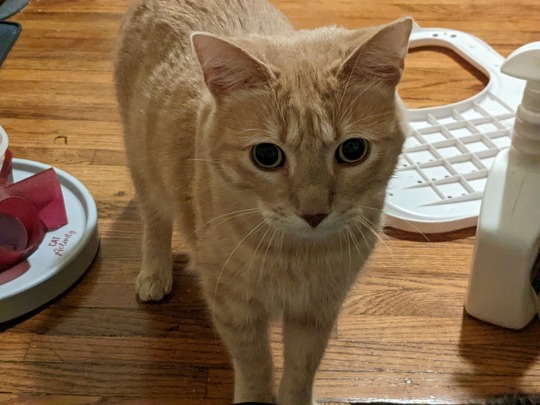
Arthur is what we call cortically blind. As a kitten, he had an intact pupillary reflex and could probably see light vs dark, but he also had severe nystagmus, so his pupils jittered uncontrollably all the time and he probably didn't get a whole lot of useful visual input. Without the visual experience of seeing things and learning how to organize and process visual information, his brain as he developed went "you know what? fuck this" and stopped dedicating any processing power to whatever visual input he was getting.
Basically, he lost visual acuity because the information he was able to pipe to his brain was fragmented and poor-quality enough that his brain stopped bothering to process it. If I pulled his current eyeballs out and magically hooked up new totally functional ones, he wouldn't be able to do anything with them: his brain has given up sorting out the information.
So the question of whether theoretical CMY humans could distinguish colors better than RGB humans is driven by two things: one, whether having two highly-overlapping cones helps you distinguish between slightly variant light types better than very different cones, and two, whether we're extending the total visual range by moving the cones at the external ends of the range (B and R) farther apart. Overlapping but unique sensory information can be really helpful for localizing and distinguishing similar-but-not-identical inputs--that's one of the reasons owls are good at localizing quiet noises, actually, their ears are wildly asymmetrical and they can computer where a noise is made based on how loudly it can be heard with each ear, especially if the owl is on the move as it listens. Like the Doppler effect, but faster with a lot more processing power on it.
I have no idea which would be more effective, but it's a fun thing to think about!
62 notes
·
View notes
Text
Non human Ancestors
I was just thinking... often I see a lot about ancestor work (something that I don’t actually do for reasons lol) which is mostly aimed to human ancestors, our beloved past generations that we never were able to know; but I was taking a shower and it occurred to me: What about our ancestors that are so back in time that are not even human? They existed, right?
Specially having in mind that humans (“modern” humans) are actually so new in the big scheme of the evolution line. As someone said, from Jesus (Year 0) to now, to around 30 years between generations, there are around 56 mothers long (some put up to 80 or 100 mothers). Which is an actually ridiculously small fragment of time. Don’t get me wrong, is a lot of time to us, but the earth is quite oldy. Also, interesting fact: 1 generation ago you have 2 parents, 2 generations ago you have 4 grandparents… 56 generations ago you have 16,000,000,000,000,000 ancestors! So each time you do ancestor work, you have a little army up there lol.
Back to what matters. There were humans before the year 0. There was a moment when they were not even humans, but their evolved blood still flows on out veins, their evolutionary bias still affects us. We find calmness on the shower because we once were living on the water. Our strong emotional based reactions come from the times where our rational thinking wasn’t a thing. The appendix is considered a small leftover from one of our plant-eating ancestors. The coccyx is all that remains of our ancestral tails. Humans pay extra attention to the red color because was a sign of a ripe fruit (and blood). Hiccups might be attributed to an ancient amphibian ancestor. That we and other mammals have 5 fingers is rooted to a dang fish! Our fear of dark, the way we unconsciously analyze others, how we manage to unconsciously pick the “best partner”, the virus and bacteria that live in our bodies in a symbiotic way, and so on. Almost all what we are now, mentally, emotionally and physically, is a result of millions of years of evolution, of species that don’t look like us. An almost endless line of lucky and well adapted creatures, in a web of evolution, trial and error, until now. So why only focus on our modern human ancestors? One of you ancient grandmothers was a “fish”, she did her part and she know things that we have no idea, so why don’t ask them for aid?
From the Homo Sapiens (Us, in the last 500.000 years) with their extreme mental developed brains, their, inventive, problem solving, creativity, to the Homo Erectus being the first to cook food (controlled fire), to make handaxes, to hunt and gather in coordinated groups, in caring for injured or sick group members, to walk fully straight as us; to the Australopithecus, and back to our unknown Hominini “Missing Link”.
From the Purgatorius, the progenitor of primates, to the Pelycosaur, the one from which Sauropsids (the ancestors of reptiles of all sorts) and of Synapsids (that's mammals AND their ancestors) split off from.
From the Hylonomus, the first reptile, to the Tiktaalik, the first fish in venture to leave the ocean and walk in the earth, to the Agnatha, the first fish.
To the Urmetazoan, the hypothetical last common ancestor of all animals.
3.7 billion years old of ancestors. I think is poetic to think about it. The spirit of some Homo Erectus getting happy when you lit a candle, the Tiktaalik’s spirit noticing how you are in ease when you take a long shower, a fluffy Synapsids’s energy remembering their old times when you sleep comfy on your bed, an anxious Purgatorius’s spirit who see you eat your veggies just like they did… So many unknown ancestors, from the most primitive form of life, seeing their evolutionary mark on you.
I don’t know, maybe is time to drop a snack in their name, who knows which knowledge they can bring us back, from their experiences in a time where life wasn’t easy, from a time where the earth wasn’t even remotely similar to our earth now. We are almost aliens to them, but we carry them, deep inside our DNA. Who knows in which funky animalistic way they can aid us? Is worthy to think about it, at least for a while. They deserve the recognition too…

#witchcraft#witch#pagan#paganism#witchy#witchblr#witches#ancestor work#ancestors#advance witch#advanced witchcraft#nature#i don't consume weird stuffs i swear
57 notes
·
View notes
Text
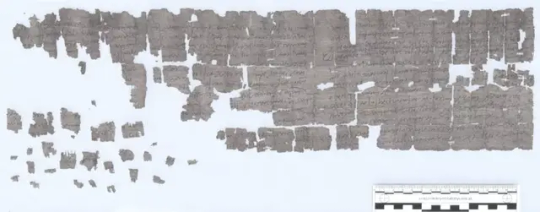
Archaeologists Find Roman Centurions' Letters in Ancient Animal Cemetery in Egypt
Discovered among the graves of hundreds of cats, dogs and monkeys, the correspondence was likely written by centurions in the first century.
An ancient pet cemetery in Egypt is becoming a gold mine for rare Roman history. Alongside its carefully constructed graves of more than 200 beloved cats, dogs and monkeys, archaeologists have now found letters handwritten 1,900 years ago by Roman centurions stationed nearby.
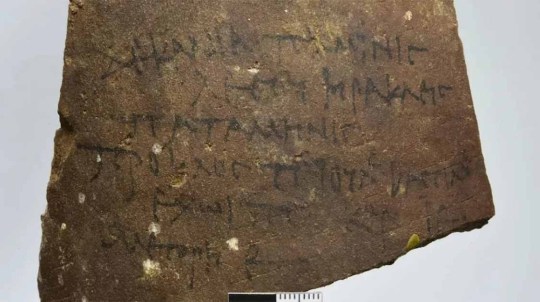
Though Rome controlled Egypt for centuries—from the year 30 to the mid-600s—few Roman sites still exist in the region, lead researcher Marta Osypińska, an archaeologist at Poland’s University of Wrocław’s Institute of Archaeology, tells Science in Poland’s Ewelina Krajczyńska. The burial ground, which dates back to the first and second centuries, is located in Berenike, a Red Sea port in southern Egypt built by Roman Emperor Tiberius.
Osypińska’s team first discovered the cemetery in 2011, and they’ve been slowly excavating it since then. Among the burials of cats, dogs and exotic monkeys, researchers have found ceramics, Roman coins and now, several letters written on papyrus by military officers who commanded units of Roman legions.

According to a statement by the University of Wrocław, these “priceless sources of knowledge about the ancient inhabitants of Berenike” are from the era of Emperor Nero, a cruel Roman ruler of the mid-first century. During his reign, Berenike was a hub of cross-continental trade, through which goods from India, Arabia and East Africa flowed, Osypińska says in the statement. The port was home to regional merchants, Roman higher-ups in charge of trading and—as historians have long suspected but never before proven—a unit of the Roman military.
The newly-found correspondence contains several names of presumed Roman centurions: Haosus, Lucinius and Petronius. In one letter, Petronius asks Lucinius, who is stationed in Berenike, about the prices of some exclusive goods, Osypińska tells Science in Poland. Petronius writes that he’s sending money via “dromedarius,” a unit of Roman soldiers traveling on camels, and tells Lucinius to provide the soldiers with veal and tentpoles.
Researchers believe ancient Romans likely kept the papyri in a nearby office which was later destroyed, accidentally distributing its contents over the pet cemetery, as McClatchy’s Aspen Pflughoeft writes. Excavators found the papyrus in rolled fragments, which they showed to Rodney Asta, an expert of ancient inscriptions, who pieced together a page approximately one and a half feet long and a foot wide, Osypińska tells Science in Poland. Among the animal graves, researchers have found countless ostracons—pieces of pottery etched with writing—but the papyri are the first paper texts to be found on-site.
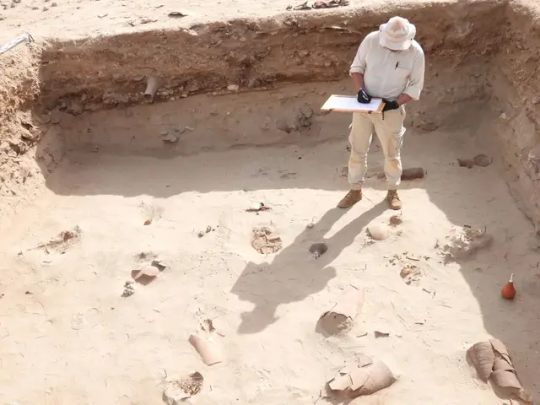
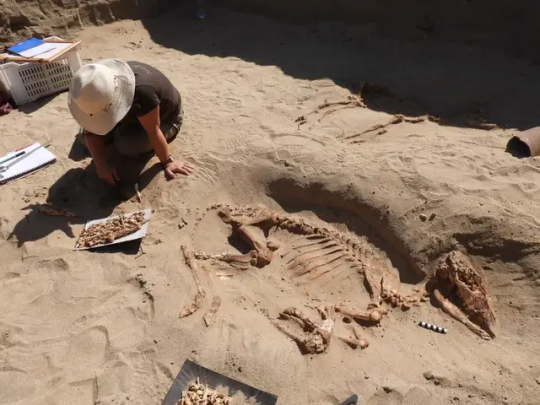
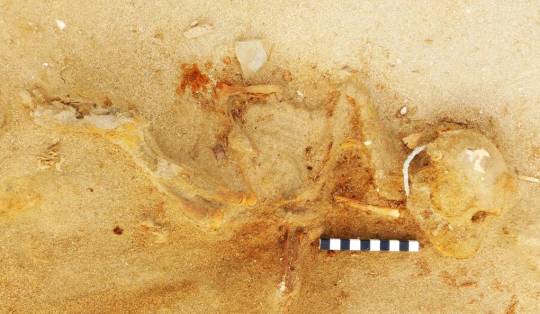
The letters are the latest evidence of advanced Roman trade to be found in the cemetery, per the statement: The skeletons of several buried monkeys, recently identified as macaques native to India, show that Romans imported non-utilitarian animals across oceans. These primates, along with long-haired cats and miniature dogs, were “elite pets,” and many were buried with toys, ceramics or other animal companions.
As Osypińska notes in the statement, it may seem difficult to reconcile the image of commanders of an ancient foreign legion with such animals, which were “treated as family members.”
“However, our findings unequivocally show that the military elite surrounded themselves with elite pets and led an exclusive lifestyle,” she adds.
By Sonja Anderson.

#Archaeologists Find Roman Centurions' Letters in Ancient Animal Cemetery in Egypt#Berenike#ancient pet cemetery in Egypt#Roman Emperor Tiberius#ancient artifacts#archeology#archeolgst#history#history news#ancient history#ancient culture#ancient civilizations#roman history#roman empire
74 notes
·
View notes
Text
First Line Tag Game
Thanks for the tag @stervrucht! Though this reminds me I have some WIPs I need to update….
RULES: post the first lines of your last 10 fics/chapters posted on AO3 (if you have less than 10 fics posted, post the first lines of all your fics) and try to draw some conclusions.
1 ) Confession - Stranger Things
Eddie Munson was bi.
2 ) Blackmail - Stranger Things
“You’re a queer?”
3 ) Coming Out - Stranger Things
Of all the people Steve had thought he’d come out to first, Jonathan Byers had not been one of them.
4 ) Uncle, I’m Coming Home - Stranger Things
“And that should be that,” the government lackey says, closing their briefcase with a marked finality.
5 ) A Hug and a Star Blanket - Kipo and the Age of the Wonderbeasts
He didn’t understand these other primates.
6 ) The Amazing Misadventures of Body Swapping - Marvel Cinematic Universe
Parker looked far too pleased with the situation, Tony couldn’t help but mutinously think as he watched the kid trying to smother giggles behind shaking fingers.
7 ) Tickle-Me-Mycroft - Sherlock (BBC)
I’m going to kill Sherlock, Greg thought to himself, not for the first time in his life.
8 ) Web of Lies - Sherlock (BBC)
Jim Moriarty isn’t stupid.
9 ) The Lighthouse - Sherlock (BBC)
I can’t remember a time without him.
10 ) Home - Sherlock (BBC)
The flat was quiet.
CONCLUSION: I really love abrupt, fragmented sentences. But I already knew that. I also become hyper fixated EASILY. And love writing gay shit lmao.
No pressure tags, and if you’ve done this challenge already, let me know so I can check it out!: @katyawriteswhump @steddiecameraroll @mugloversonly @endlessmusings1801
#first line tag game#ao3#fanfic#stranger things#mcu#kipo and the age of wonderbeasts#bbc sherlock#steddie#mystrade#johniarty#johnlock#tag you’re it
18 notes
·
View notes
Text

I've gotten a bit of interest in terms of the designs and backstories I've been creating for Sun Wukong's children from Journey to the South, and so decided to post some of my current ideas for Yuebei Xingjun, the Monkey King's large and powerful daughter. Some sketchy thoughts below, with a quick heads-up that there is talk of violence and child death.
The underlying idea here is that the monkeys that do not belong to any of the ten species--i.e. the spiritual primates--come into existence in pairs: the red-buttocked baboon and the bare-armed gibbon; the intelligent stone monkey and the six-eared macaque; and some 500 years after the westward journey is over Sun Wukong adds to that number by crafting his sons Qidou and Luohou from fragments of carbonized bone from the Mt. Huaguoshan massacre and debris from the mountain that the Monkey King, being a stone and therefore a lava monkey, melted and squeezed into the shape of another divine rock out of which his sons were eventually born. Some 500 years after this Sun Wukong decides to expand his immediate family and repeats the process. Yet this time, the vagaries of nature result in his daughters Yuebei and Ziqi not only being born thoroughly conjoined at the head and the brain, but Ziqi dies a few seconds after emerging from the rock. Heartbroken and desperate to at least save a rapidly fading Yuebei, the Monkey King uses his vast knowledge of medicine to perform emergency surgery on his surviving daughter. While it's too dangerous even for him to try and "detangle" Yuebei from Ziqi completely, he does manage to save Yuebei, even though she's left with her sister's face forever merged with her own.
Though Yuebei Xingjun had often been left in tears at the comments of visiting entities on her appearance, the consistent love of her father, brothers, and extended family gave her a pretty happy childhood and gives her a pretty happy life as an adult. Even so, the devastation Heaven's war against Sun Wukong left on Mt. Huaguoshan gave her a bitter hatred against her father's past enemies, and left her fearful of the prospect that her family would face extermination once again. Though the Monkey King frequently warned her against letting this hatred fester, and though both father and daughter were often left perplexed as to why Yuebei Xingjun wasn't capable of learning any of the magic Sun Wukong possessed and tried to help her cultivate, she later found out through listening to the voices of her deceased family members who were killed in the war against Heaven, who were now being led by Ziqi in Diyu, and all of whom refused to enter the cycle of reincarnation until they felt they had been appropriately avenged--that she was capable of cultivating powerful death magic. It was through their help that Yuebei Xingjun eventually formed her skull treasure, which only she can wield and which gives her the ability to curse anyone, even immortals, with a death spell so powerful that it inevitably kills its victims within three days. This was something that caused an paradoxical escalation in tensions and desire for further negotiations between Mt. Huaguoshan and Heaven when it was first revealed. Between the fact Yuebei Xingjun agreed to only use her death curse if her father allowed her to do so and the still sharp memories of the devastation Sun Wukong wreaked during his havoc in heaven, the monkey yaoguai and Heavenly deities now exist in something of a tense peace under a kind of mythological M.A.D. situation. In the centuries since that agreement during which Yuebei Xingjun became one of Mt. Huaghushan's guardians and further appointed herself a "helper in hell" to try assisting her deceased family members in moving on, she furthered her study of curses, and has become extremely proficient in both making and breaking them, something that has become very useful for strengthening diplomatic ties between the Mt. Huaguoshan monkey yaoguai and the yaoguai, immortals, and even humans of other regions.
She also enjoys afternoon naps in Mt. Huaguoshan's orchards, making sculptures from stone, and traveling with her brothers. She's further currently being courted by two monkey yaoguai from other caves, both of them having became enamored with her after she saved their lives. After a lifetime of hearing whispered insults from other entities Yuebei Xingjun is scared to pursue either relationship due to the fear that they're playing a cruel joke on her, but her friends and family are trying to bolster her confidence.
#jttw au#yuebei xing#yuebei xingjun#yaoguai#monkey yaoguai#shark's sketches#journey to the south#reminder that the cool thing about jttw and some of its related media#is that many of the characters are so brief in appearance that you're basically being given a free oc
29 notes
·
View notes
Text
Other people have got to be posting about this better than I can, but maybe this will help my particular audience of curious seekers
Wanted to share for ages
I've been reading a lot about this discovery and have desperately wanted to share and to talk about it. A Netflix documentary on an archeological discovery that does literally shake the foundation of everything since.
Humans are far, far from the first to ritualize our dead in ways that are recognizable in the fossil record to other primates. I'd argue we miss most evidence of most things.
We aren't the first as a species to create art to ascribe meaning to death. To close in the hands of our loved ones, the tools we used to mark the cave walls of a journey into a vaster existence.
The news articles that made the published work comprehensible for most people haven't come anywhere close to the depth of what's being found.
This is foundation shaking. This is not just another interesting documentary to see when you have the time. At least, from what I take for granted about my worldview it isn't? Maybe I've been weeping and this is just a footnote for you but give it a chance.
Most of you probably don't know about my time interning in a zooarcheology lab at Indiana University, working with bones. Cradling and counting and identifying thousands of bird bones. Seeing my colleagues catalog fossil fish bone fragment from pottery sherd.
How all consuming a need I have to understand our infinitely small place here, and how since my first word I learned, knew we are not separate from other animals.
Documentaries don't generally focus on what the scientists actually find meaning in, or contextualize why they do. This was so beautifully done.
I respect this (yet another) white man in archeology more for actually trying, for a moment, to communicate the timeless spiritual connection I feel most archeologists do experience. Something core they can't make sense of, outside of organized religion or the idea of BELIEF in mythology, vs a sensation and knowing deeper than the trappings of life.
Western colonialist detachment has fucked us all so deeply.
I found myself talking back to the narration a few times about how small and human-centric our worldview still is even as we literally descend into the earth to find the pasts, not even of us, but of those who prove what makes us unique actually makes us more a part of the whole
"Unknown: Care of Bones"
aka the first archeological film to show how true revelatory discovery feels, when everyone I have worked with finds meaning in uncovering small scraps
https://www.netflix.com/us/title/81473682?s=a&trkid=13747225&trg=cp&vlang=en&clip=81696485
33 notes
·
View notes
Text
Chapter 3 Trivia
The world's strongest primate highschooler has arrived!
Pouring revival fluid onto any petrified part reverts it to flesh. Sticking the pieces back together also apparently doesn't work, but it's unclear what the test was: did he put together a whole statue? Or did he just try sticking the dead flesh back onto a partial statue?


The last part is especially interesting, because it could mean that reviving someone with a missing stone arm means they'll be brought back dead rather than simply amputated.
The other possibility is that Senku's tests were missing some other key factor for revival.
Fun fact! Yuzuriha doesn't have junk.
Joking, but seriously it seems that stoned Yuzuriha is heavier than non-stoned Yuzuriha, going by Senku's comment. Where's this extra mass coming from during petrification?
Taiju also makes sure to hold her appropriately. What a nice guy :)

Lions in Japan? Pretty unlikely. Senku assumes they're zoo escapees which could be possible, since lions were never native to Japan. The issue here is that lions prefer to hunt in savannahs since they're more open, but here they're giving chase in a moderately dense forest.
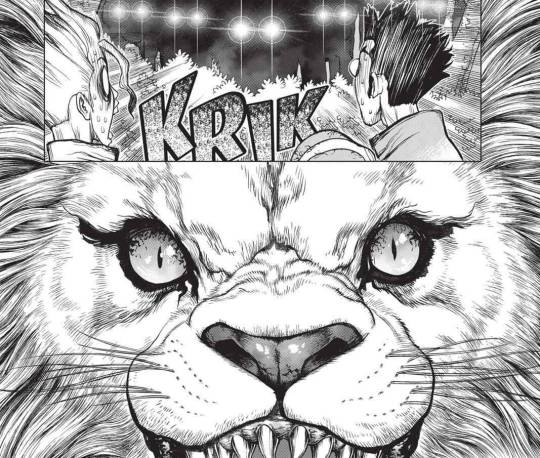
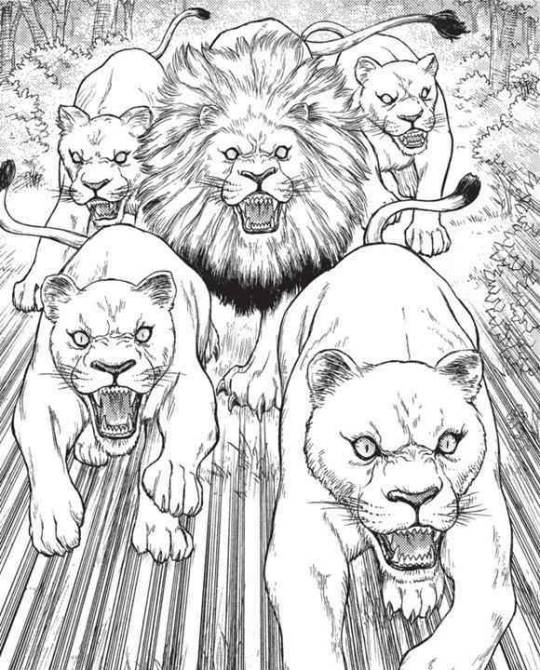
Looking at the group, we can see 4 females and 1 male lion. Normally the females hunt in groups, but males would hunt alone and in different areas. This whole setup seems a little odd/almost impossible from what I've read, but if anyone's got any other insight, please do comment.
Taiju's been taking punches for Senku since they were ~10 years old? Why would these highschoolers be beating up these little kids and why is Taiju so okay with this? Has he been getting bullied even before meeting Senku?
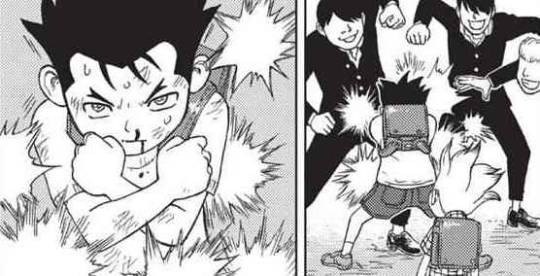
Taiju pours the revival fluid onto the plant rather than on Tsukasa's shoulder or another exposed part of the rock. Why he does this I have no idea, but at least we know it works.

The initial depetrification cracks seem to be the ones that leave scars. This makes sense because the scars are the worn-down parts, and the RF has to sink into the layers of stone for it to activate. The cracks are probably the most shallow areas and thus depetrification begins there.


Fun little detail here: Senku's ducks, knowing what's coming, but Taiju doesn't realise until he's hit with several of Tsukasa's stone fragments. You can even see Senku still on the ground on the right!
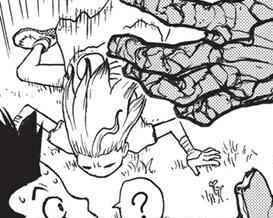
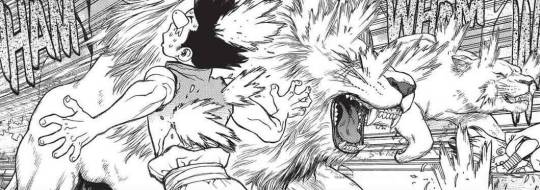
26 notes
·
View notes
Text
Conservation of A Great Ape: The Orangutan
The orangutan, known for its distinctive red hair and human-like behavior, is one of the most endangered primate species in the world. Found only on the islands of Sumatra and Borneo, these intelligent and gentle creatures are threatened by habitat loss, poaching, and the illegal pet trade. Conservation efforts are essential to protect the remaining populations of orangutans and ensure the survival of these majestic creatures in the wild.
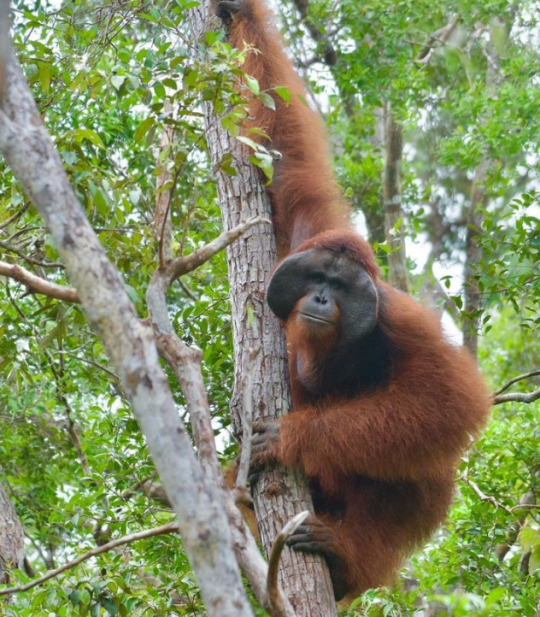
The Ecology of the Orangutan
Orangutans are the largest arboreal mammals, with adult males weighing up to 200 pounds and standing around 5 feet tall. Their long, powerful arms enable them to move through the trees with ease, and they use their four-foot-long arm span to reach branches that are too far away for their legs to reach. Orangutans have long fingers and toes with opposable thumbs, allowing them to grasp objects with great dexterity, making them proficient tool-users. Their hair is a distinct reddish-brown color that fades to gray as they age, with males developing distinctive cheek pads that grow throughout their adult lives.
Orangutans are also incredibly social animals, with complex communication skills and strong family bonds. Female orangutans maintain strong bonds with their offspring, raising them for up to eight years before they become independent. Adult males, on the other hand, are solitary and territorial, only interacting with females during breeding season. While orangutans are generally peaceful, males have been known to display aggressive behavior towards other males, especially during mating season.
Unfortunately, these intelligent creatures are under threat from a variety of human activities, including deforestation, poaching, and the illegal pet trade.
youtube
What threatens the Orangutan?
The primary threat to orangutan populations is habitat loss. Deforestation, driven by logging, agriculture, and palm oil plantations, is the most significant cause of habitat destruction in Borneo and Sumatra. In the past few decades, the orangutan’s habitat has been reduced by 80%, leaving the remaining populations confined to small, isolated pockets of forest. This fragmentation makes it difficult for orangutans to find food, mate, and establish social connections, which can lead to a decline in their population numbers.
In addition to habitat loss, orangutans are also threatened by poaching and the illegal pet trade. Orangutan babies are often captured and sold as pets, while adult orangutans are hunted for their meat or body parts, which are used in traditional medicine. Poaching and the illegal pet trade have contributed to a decline in the orangutan population, and it is estimated that only 80,000 orangutans remain in the wild today.
Conservation of the Orangutan
Conservation efforts are essential to protecting orangutan populations and ensuring their survival in the wild. One of the most critical steps in orangutan conservation is habitat protection. Protecting orangutan habitat means preserving the remaining forests where orangutans live, and creating corridors between fragmented forests to enable populations to intermingle and reproduce. It also means reducing the impact of human activities such as logging, agriculture, and palm oil plantations, which are driving deforestation in Borneo and Sumatra.
Another key conservation effort is anti-poaching and law enforcement. Strict laws and regulations must be enforced to prevent illegal hunting and the illegal pet trade. Wildlife rescue and rehabilitation centers are also essential for orangutan conservation, providing a safe haven for rescued orangutans that have been injured or orphaned. These centers help rehabilitate orangutans and prepare them for release back into the wild.
Community engagement is another crucial aspect of orangutan conservation. Local communities play a vital role in protecting orangutan habitat and reducing the impact of human activities on the forest. Engaging with these communities, educating them about orangutans, and empowering them to participate in conservation efforts can help build support for orangutan conservation and reduce the impact of human activities on the forest.
We at Think Wildlife Foundation recently launched our Livelihoods for Conservation project to provide alternative, sustainable livelihoods to the communities living with wildlife. This is with the aim to incentivize conservation while uplifting these communities economically. You can purchase merchandise from these communities here!
Written by: Sanghmitra Singh
Originally published at https://thinkwildlifefoundation.com on June 29, 2023.
13 notes
·
View notes
Text
instagram
0 notes
Text
ENT Rewatch Starlog, 27 January, 2024: Episode 3.07 “The Shipment”
Archer leads Enterprise to the colony planet identified by the psychic Tarquin and they find a facility controlled by Xindi Arboreals manufacturing a substance known as kemocite. He takes Malcolm and Major Hayes—leader of the MACOs—to the surface in a shuttlepod while Enterprise hides in the moon’s orbit.

Their investigation of the facility leads to them detaining the project’s head in his nearby home; a Xindi named Gralik.
On Enterprise, Trip is investigating the Xindi Reptilian weapon they captured and realizes it has biological components. He asks Phlox to start investigating the strange worm-like creatures that seem to help regulate the weapon’s power.

Archer confronts Gralik about the kemocite he’s producing being used as a weapon, and has T’Pol and Trip beam down a fragment of the original probe to prove that the kemocite used there came from this facility. Gralik is aghast that his work could be used in the death of 7 million people, and begins to reveal some history of the Xindi people. He’s been working with a Xindi Primate (“Like you, ape-like”) named Degra who is in league with the Reptilians. The nature of the Xindi now is based on the aftermath of their century long war that not only ended with the Reptilians and Insectoids destroying the planet but the extinction of a sixth Xindi species, the Avians. Enterprise warns Archer that there is a ship approaching; Degra and the Reptilians have come for their kemocite early.

Phloc determines that delta radiation can kill the battery worms in the Reptilian weapons, but omicron radiation will make them breed. Trip is initial planning to make an EM emitter which could disable the weapons, but Phlox warns the radiation necessary would be very harmful to humans. They decide they now have to test the weapon.
After a little cat and mouse with some Reptilian probes who want to know where Gralik is, Archer trusts him to go back into the facility and deal with Degra. He quietly taints the shipment, knowing this is the last Degra has ordered, so whatever weapon they’re making must be close to being complete. He also arranges for Archer to sneak a marked container onto the ship to allow Enterprise to follow where the shipment goes.

When Trip tries to fire the Xindi rifle, it goes into overload, and he barely has time to beam it off Enterprise. They realize the Reptilians have rigged their rifles to self-destruct on any unauthorized user.
After Degra has left with the kemocite, Archer shares a drink with Gralik. Degra had confessed to Gralik that they were building a weapon, but to deal with a “ruthless alien species,” and Gralik wonders if he betrayed his people. Archer promises he has not, but Gralik reminds him to remember that whatever Degra and the Reptilians are up to, not all Xindi are his enemy. Archer tells him the Reptilian ship jumped into a portal and they’ve lost the tracking signal, but Gralik responds that the portal range is only a few light years, and he must keep searching.
A very strong offering in this story arc, and very Star Trek in the idea that we shouldn’t be casting species-wide conclusions about intent. The point is slightly blunted by the fact that the episode really goes out of its way to present the mammalian Xindi as more reasonable while the Reptilians and Insectoids are vicious and not to be trusted. It’s not the first time Trek has based aliens on Jungian archetypes or painted a species with a broad brush (WHERE ARE THE KLINGON GARDENERS???), but in retrospect it’s a slightly sour note in an other very well paced and written episode.
I admit I forget where the research on the Xindi weapons is going in the overall arc, so I am looking forward to seeing how that plays out, rewatch or not; I haven’t watched ALL of this arc probably since it first aired, and I’m a little older than I used to be. I don’t always remember the details in Enterprise like I might from DOZENS of rewatches of TOS done in my youth!
And, as I already mentioned Klingons, just want to point out the actor playing Gralik here, John, Cothran Jr. had appeared as Klingons on both TNG and DS9, and notably is the Klingon Captain Nu’Daq who remarks at the end of the TNG episode “The Chase” that if the ancient humanoid who seeded the galaxy “were not already dead, I would KILL her!”
Next Voyage: An anomaly removes Archer’s ability to form long-term memories and he awakens to find he has forgotten 12 years of Human/Xindi conflict, and the entire human race is now in its “Twilight.”
(Images taken from the main website for @trekcore; I am happy to remove the images if asked.)
4 notes
·
View notes
Text
Celestial Primate ! MK
[One of the Alternate Universes that can be requested for people who like alt-first meetings!]

tldr; What if MK was born in his demon form and never met Sun Wukong or trained under him.
(Kinda half-headcanon on MK's origins, half-what if scenario.)
His Celestial Primate name is Zodiac Clay Monkey /Shengxiao Ni'hou although I don't know any chinese so it is up to be changed, I wanted to keep the four character naming scheme the other Celestial Primates have.
He still answers to MK, as it is his preferred name, but Celestial Primates are kind of a big deal, and suddenly finding out a fifth one has been living among those the mortal realm is also, kind of a big deal.
MK hasn't been properly trained, nor does he have Monkey King's staff, unless someone goads him into picking it up and releasing DBK. He fights a bit more feral, tooth and nail, and uses his electric and technomancy powers to do most of his scrapping, but he's not one to pick fights.
He wants to be a regular noodle delivery boy for his Dadsy like in canon, but its kind of hard when your one of only five of your kind and people keep giving you weird looks or trying to kidnap you and drain your power.
Shengxiao was carved using clay from Flower Fruit Mountain, with fragments of Sun Wukong's stone mixed into the mud, along with other creatures based on the Zodiac and other constellations like Ursa Major. Shengxiao is the only figure to come to life. This gives him access to the same powers as the Great Sage Equal to Heaven, though they're mostly dormant.
Before he was finished being created, the celestial realm attempted to destroy him, causing him to be incomplete and fractured spiritually. This storm also knocked him off Flower Fruit Mountain and sent him to the mainland, where Pigsy took the still underdeveloped monkey demon in and raised him as his own.
9 notes
·
View notes
Text
Vaccines currently in development
(I did not create this list and I'm sorry I don't know the original OP who compiled it.)
These are all currently in development to come to market in the next 2 years. If just one really works it will be a game changer
MT-001 a novel protein component vaccine candidate, MT-001, based on a fragment of the SARS-CoV-2 spike protein that encompasses the receptor binding domain (RBD) | A SARS-CoV-2 Vaccine Designed for Manufacturability Results in Unexpected Potency and Non-Waning Humoral Response - https://www.mdpi.com/2076-393X/11/4/832 Mice and hamsters immunized with a prime-boost regimen of MT-001 demonstrated extremely high anti-spike IgG titers, and remarkably this humoral response did not appreciably wane for up to 12 months following vaccination. Further, virus neutralization titers, including titers against variants such as Delta and Omicron BA.1, remained high without the requirement for subsequent boosting.
DCFHP a ferritin-based, protein-nanoparticle vaccine candidate that, when formulated with aluminum hydroxide as the sole adjuvant (DCFHP-alum), elicits potent and durable neutralizing antisera in non-human primates against known VOCs, including Omicron BQ.1, as well as against SARS-CoV-1. | A ferritin-based COVID-19 nanoparticle vaccine that elicits robust, durable, broad-spectrum neutralizing antisera in non-human primates https://www.ncbi.nlm.nih.gov/pmc/articles/PMC10110616/#MOESM3
ISM3312 a COVID-19 drug entirely designed by generative AI works by inhibiting a protein called 3CL protease — a critical factor in viral replication and a popular target for anti-COVID drugs. Unlike similar therapeutics, it works on a very broad spectrum — showing efficacy not only against all current COVID variants, but also coronaviruses other than SARS-CoV-2. As such, it may possess the ability to resist future mutations, providing a solution to drug-resistant strains. | ‘It’s perfect’: World’s first generative AI-designed COVID drug to start clinical trials https://www.thestar.com/news/canada/2023/02/23/its-perfect-worlds-first-generative-ai-designed-covid-drug-to-start-clinical-trials.html
BNT162b4, composed of a T cell antigen mRNA encoding for SARS-CoV-2 non-spike proteins that are highly conserved across a broad range of SARS-CoV-2 variants and will be evaluated in combination with the Omicron BA.4/BA.5-adapted bivalent COVID-19 vaccine | Pfizer and BioNTech Advance Next-Generation COVID-19 Vaccine Strategy with Study Start of Candidate Aimed at Enhancing Breadth of T cell Responses and Duration of Protection https://investors.biontech.de/news-releases/news-release-details/pfizer-and-biontech-advance-next-generation-covid-19-vaccine
25F9 and 20A7 identified as two highly potent broadly neutralizing antibodies, making them promising prophylactic candidates against sarbecovirus infection |Broadly neutralizing antibodies against sarbecoviruses generated by immunization of macaques with an AS03-adjuvanted COVID-19 vaccine – Science Translational Medicine – https://www.science.org/doi/10.1126/scitranslmed.adg7404
ChAd-SARS-CoV-2-BA.5-S, which encodes for a pre- fusion and surface-stabilized S protein of the BA.5 strain. | A bivalent ChAd nasal vaccine protects against SARS-CoV-2 BQ.1.1 and XBB.1.5 infection and disease in mice and hamsters https://www.biorxiv.org/content/10.1101/2023.05.04.539332v1
#covid#covid vaccine#vaccines#treatment#will it be like this forever#'will you mask forever?'#research#science#neutralizing vaccine#coronavirus
4 notes
·
View notes
Text

Antauri had noticed something was up first. Chiro had always been prompt about his training, putting his all into it. Some things he didn't grasp instantly but that was expected. He had been making leaps and bounds though in such a short time, they all had noticed it but now… There was something else going on behind the boy's eyes that took him away from the moment. He was still paying attention but it was fragmented. However, now it was common to notice him clearly lost in thought thinking about something else or sneaking his phone out during his lessons to check it. Chiro was currently sitting in Antauri's room as part of his training with the Power Primate. Specifically, learning to still his mind so he could one day reach that place they had been once more. Meditation came first. Once he mastered that, everything else was supposed to be easier… but Antauri noticed, as he went about his room lighting some large candles and incense, that the boy was fidgeting. "Something you want to share?" "W-What?" Chiro shook his head. "No, no, nothing." Antauri raised an eyebrow, crossing his arms. It was written all over his face. Chiro wouldn't look him in the eye, instead eying where his phone was. Antauri looked over at the device. "What is on there that has you so distracted?" "It's…" Chiro sighed. He supposed he had been out of it the last few days… Brriiiiing! "I GOT IT!" He practically dove for his phone. "If it's your crazy sister you tell her we're in the middle of sparring!" Sparx called over from the middle of the training room. Chiro answered it. "Hey!" "Chiro!" Jinmay's voice came through, making his heart flutter. "Hope this isn't a bad time." "Bad time? Noooo, not at all!" "Ahem!" "Okay, actually a bit of one. Can I call you back in like 20?" "Sure!" "Well…" He mumbled something under his breath.
In which, Chiro is head over heels and can't seem to focus.
#super robot monkey team hyper force go#srmthfg#hyperforce: reignition#super robot monkey team hyperforce go#mila hanamura#antauri#chiro#gibson#nova#fanfiction#otto#Jinmay#Jinmay Kanno#Ren#Ren Kanno#HyperForce: ReIgnition#Hyper Force ReIgnition#srmthfg fanfiction#SRMTHFG AU#AU#Series rewrite#Chinmay#Spova
2 notes
·
View notes
Note
Do the Gargoyles fight? Does their conflict differ noticeably from human conflict - both at a one-on-one "bar brawl" scale and at larger ones?
Absolutely. The background conflict driving the central narrative of Stellacide Animus is the long, complex, multifaceted conflict between the human and gargoyle species. It is between many disparate fragmented nations, alliances, and corporations. There is no “war” and there is no “front” with one side against the other. Sometimes gargoyles and humans get along, but it is extraordinarily rare given the strict nigh-unbreakable language barrier (more on that later.)
But thats new! these two species just met.
Like humans, gargoyle nations have been warring with eachother since the dawn of time. The differences are really in the minute details. They use guns, cannons, artillery. planes, tanks, but ESPECIALLY ships and submarines. almost everything Anthemian is shifted to be focused just as much on the ocean as it is on land, but naval-battle is far more likely to be like the bombing of a city than just an empty battlefield to fight on. if a ship sinks, it may land on some unsuspecting farmstead.
One important advantage in this regard is gargoyles experience in advanced three-dimensional combat. Even without vehicles, their prowess in swimming basically affords them the power of flight as far as ground-wars underwater are fought. its not difficult to imagine the advantage this would provide even the most mediocre of gargoyle pilots in an aerospace-based engagement. These guys are predators used to flying around to hunt their whole lives!
As far as hand-to-hand combat is concerned, choking a guy until he faints is out of the question. Gargoyles can hold their breath for hours. While it IS possible to cut off bloodflow to the part of their brain in their head, their necks are extremely thick and thats not something youre doing with your hands, even as another gargoyle.
all gargoyles have internal genitalia, so punching below the belt isnt an option.
Their big toothy jaws are a nice extra weapon, and it’s perfectly acceptable to use in a brawl and not considered “fighting dirty.” That being said, their mandibles act almost like handles to grab onto their face with, and their whiskers are quite sensitive to touch so that doesnt feel too awesome.
Their flipper-wings aren’t worth much on dry land and even pose a risk, being big grabbable flaps attached to a person akin to having long hair.
Finally, having three eyes means its pretty difficult to get into a gargoyles blindspot!
Overall they are RUTHLESS brawlers compared to humans. one-on-one between a gargoyle and human of comparable builds and ages is without a doubt going to go the gargo’s way. i pity the primate that tries it
thanks for the ask :)
1 note
·
View note